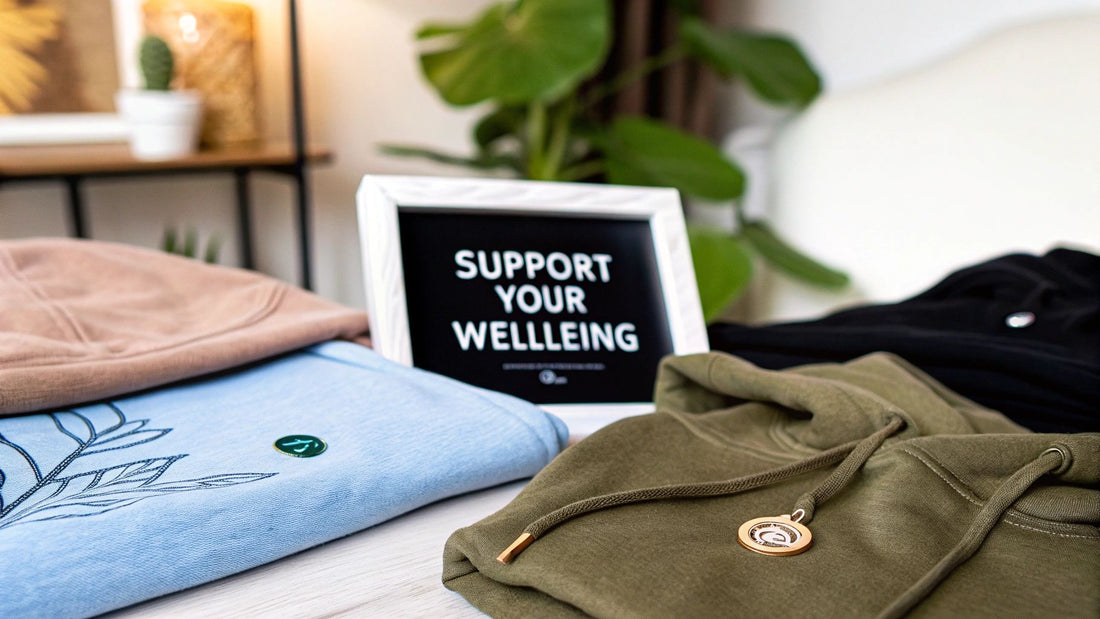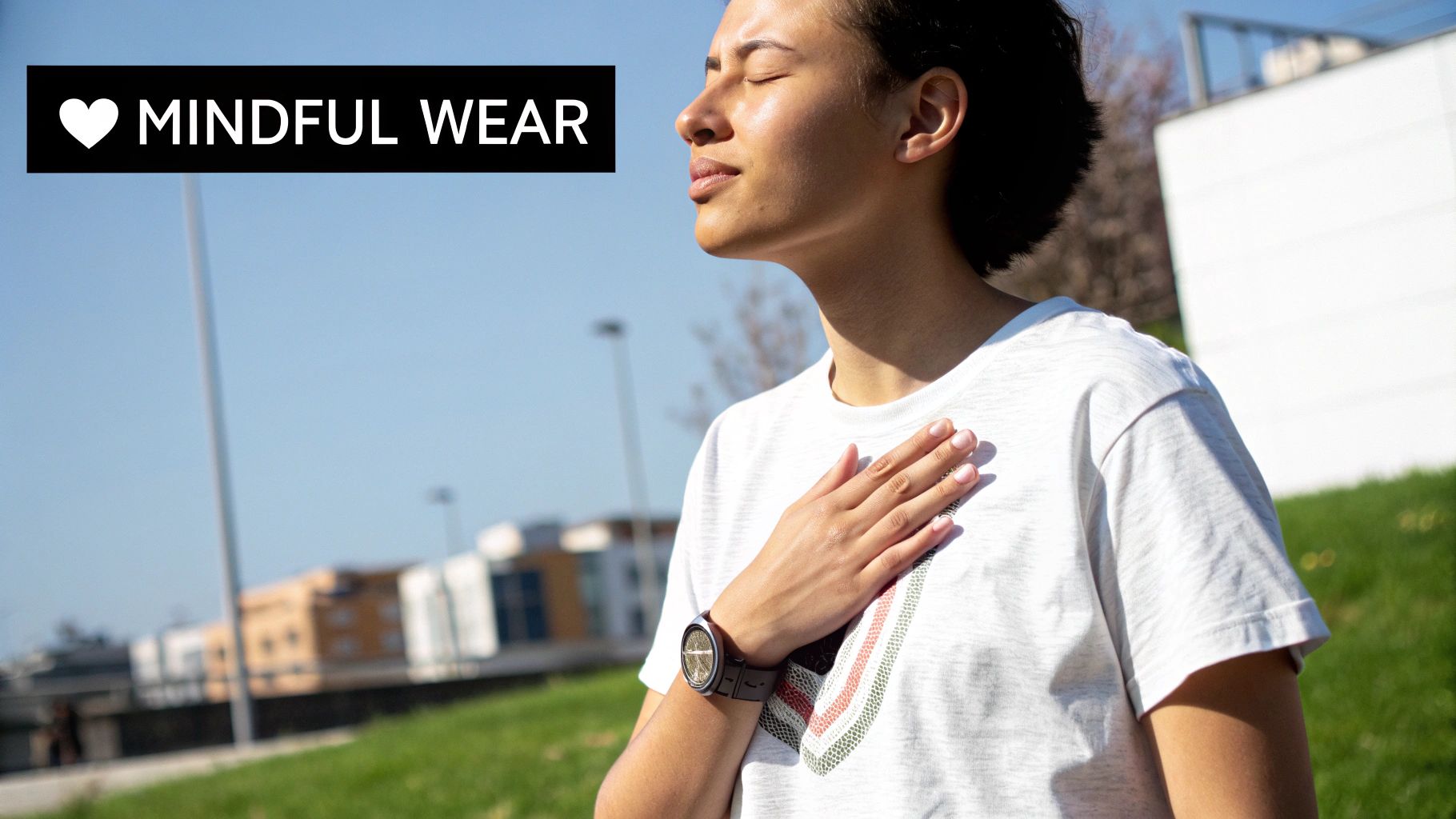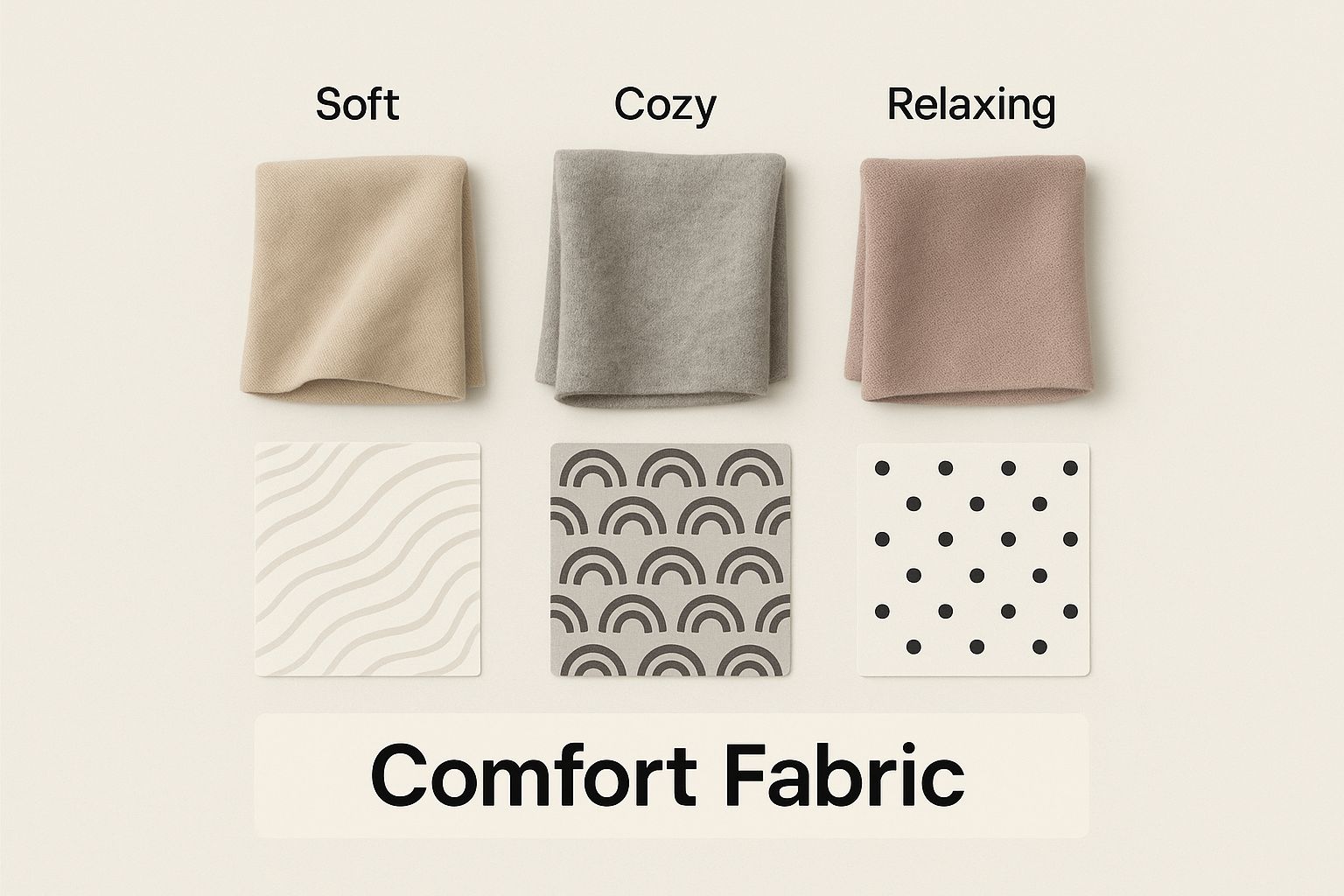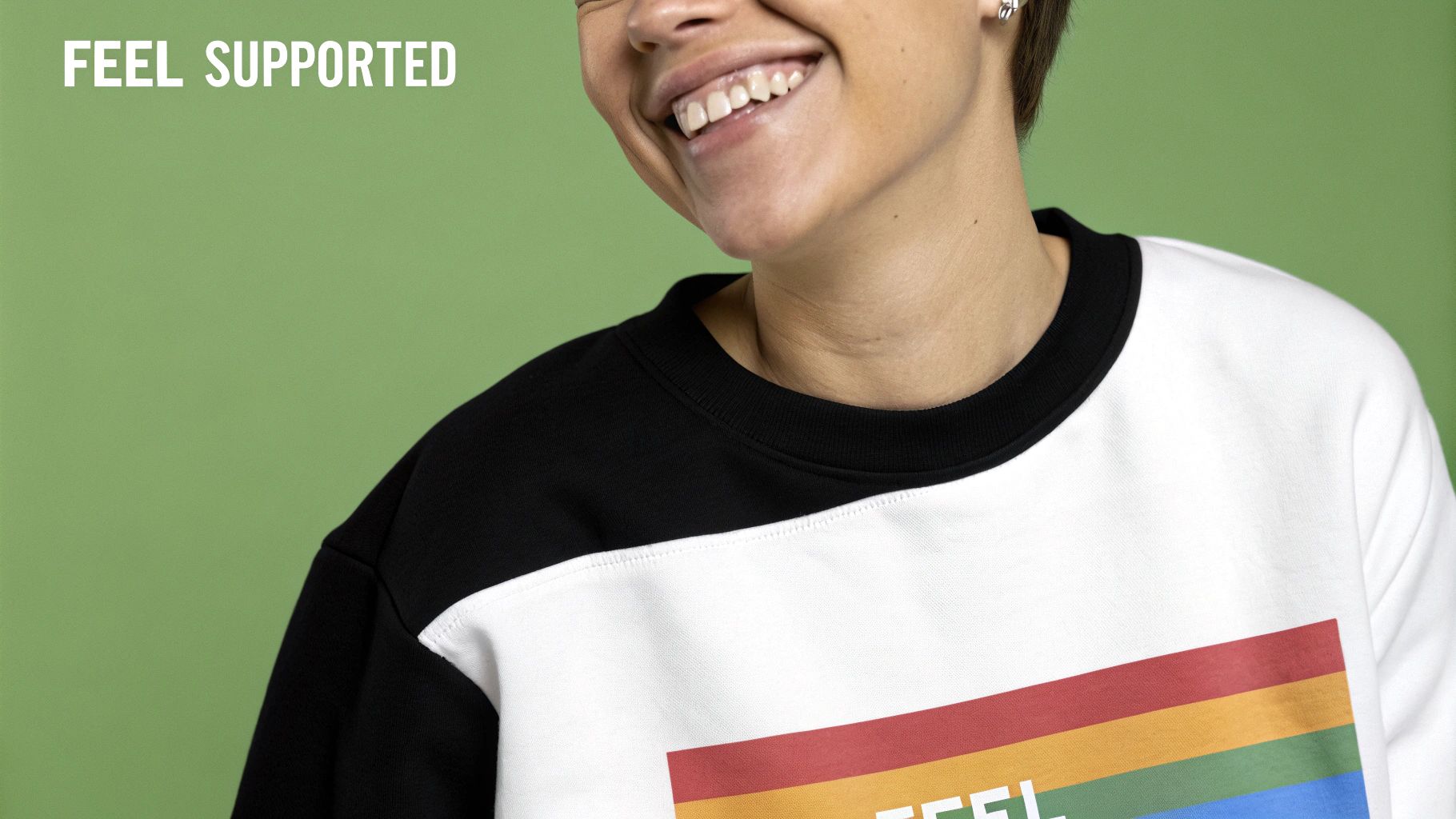
Mental Health Clothing: Supporting Your Wellbeing with Every Thread
Share
Let's be clear: mental health clothing is much more than just a passing fashion trend. Think of it as a movement, a way of wearing apparel that’s been thoughtfully designed to support your wellbeing.
These pieces often feature positive affirmations, comforting designs, or sensory-friendly materials that act as little reminders of your own resilience and the importance of self-care. It's a tangible way to wear your story, and in doing so, you might just spark a conversation that really matters.
Why Does Mental Health Clothing Matter So Much Right Now?

This growing movement in the UK isn't just about putting slogans on a T-shirt; it mirrors a huge cultural shift that's been a long time coming. As a society, we're finally starting to dismantle the stigma that has kept mental health in the shadows for far too long. Thankfully, open discussions are becoming more common and much more accepted.
This shift has naturally created space for products that actively support our emotional health. You only have to look at the numbers. The global mental wellness market is already valued at a staggering USD 159 billion, and that's just the start. Projections show it could climb to USD 355.4 billion by 2034, largely driven by a greater awareness of mental health challenges.
The isolation and disruption of the COVID-19 pandemic certainly accelerated things, increasing the demand for products that soothe and foster emotional health. You can discover more insights about the mental wellness market on insightaceanalytic.com if you'd like to dive deeper into the data.
The Deeper Importance of Open Conversation
Talking about mental health isn’t just a personal matter; it has massive implications for our communities and the economy. Here in the UK, mental health issues cost employers an estimated £53-£56 billion every single year. That figure comes from the impact of absenteeism, presenteeism, and staff turnover, highlighting just how urgently we need supportive cultures everywhere, from the office to our daily lives.
For younger generations, the conversation is especially critical. Research shows that a shocking one in six children aged 5-16 in the UK is likely to have a mental health problem. Social media often adds another layer of complexity, with the constant pressure of comparison contributing to anxiety and low self-esteem.
Mental health apparel serves as a quiet, visual cue that it's okay not to be okay. It creates a sense of solidarity and can be a gentle catalyst for someone to share their own feelings or seek help when they need it most.
It’s crucial to remember, though, that while supportive clothing and open dialogue are powerful tools, they are not a substitute for professional care. I am not a mental health professional. If you or someone you know is struggling, it is so important to speak with a doctor or a qualified mental health expert. They are the ones who can provide the diagnosis and treatment necessary for your wellbeing journey.
The Power of Wearing Your Story
Wearing your story is a quiet yet profound act. The clothes we choose can do so much more than just cover our bodies; they have the power to genuinely influence our thoughts, emotions, and even how we act. There’s a fascinating concept for this called 'enclothed cognition', which basically means that the symbolic meaning we attach to our clothing can actually shift our psychological state.
Think about it like this: just as a sharp suit might make you feel more confident before a big meeting, a hoodie with the words "It's Okay Not to Be Okay" can serve as a personal, wearable reminder to be gentle with yourself. It’s a form of self-compassion you can physically put on. For many of us, this kind of clothing becomes a real source of comfort on those tougher days.
A Quiet Form of Advocacy
This apparel also works as a subtle form of advocacy. A simple T-shirt can create an unspoken bond with a stranger who gets the message, fostering a sense of community and solidarity without a single word being exchanged. It chips away at the stigma, helping to normalise the conversation around mental health and making it a visible, accepted part of everyday life.
These garments can also be incredibly empowering for the person wearing them. Choosing to wear a piece that speaks to your mental health journey is a declaration of strength and resilience. It says, "This is a part of my story, and I am not ashamed." It’s a small rebellion against the outdated stigma that once forced these conversations into the shadows.
By wearing these messages, we are not just dressing ourselves; we are dressing the world in a little more empathy and understanding. It's a visual cue that opens the door for connection and support.
Nurturing Young Minds
This concept is especially important when it comes to children. Young people often struggle to find the words for big, complex feelings. Kid-friendly mental health apparel, with its approachable designs and simple messages like "Be Kind to Your Mind," gives them a tool to express themselves when words fail.
Statistics show that an alarming one in six children aged five to sixteen in the UK is likely to have a mental health problem. Providing them with supportive tools is more critical than ever. This clothing can help them:
- Label their feelings: A shirt about anxiety can help a child identify and name what they're experiencing. For example, a child wearing a T-shirt with a "worry monster" on it might find it easier to say, "My worry monster is really big today."
- Feel less alone: Seeing others wear similar messages helps them realise they aren't the only one who feels this way.
- Start conversations: It gives parents, caregivers, and teachers a gentle opening to talk about emotional wellbeing. A simple question like, "I love the message on your jumper, what does it mean to you?" can open up a meaningful dialogue.
Addressing mental health from a young age builds a foundation of emotional literacy that can last a lifetime. It teaches children that their feelings are valid and that it's brave to talk about them. As we continue to understand the deep connection between what we wear and how we feel, the role of clothing in enhancing our wellbeing becomes clearer and clearer. You can learn more about dressing for confidence and the power of clothing in enhancing mental well-being in our related article.
How to Choose Meaningful Mental Health Apparel
Finding that perfect piece of mental health apparel, whether it's for you or a friend, is a really personal journey. To pick something that genuinely connects, you need to look past the slogan and think about what makes it truly supportive. The aim is to find an item that feels less like clothing and more like a comforting companion on your wellbeing path.
Let's start with physical comfort. When we're feeling overwhelmed or anxious, our senses can go into overdrive, making scratchy or tight fabrics feel almost unbearable. This is why prioritising soft, sensory-friendly materials like organic cotton or bamboo can be a game-changer. It provides a grounding physical sensation, a bit like a gentle, constant hug.
The right fabric and pattern can make a world of difference in creating that sense of calm.

As you can see, soothing textures and calming patterns aren't just nice-to-haves; they're core elements in designing apparel that actually soothes and supports wellbeing.
Finding Your Ideal Mental Health Apparel
To help you find clothing that really aligns with your needs, here's a quick guide to what you might want to consider. Think of it as a checklist to help you select pieces that will bring you the most comfort and meaning.
| Consideration | What to Look For | Why It Matters |
|---|---|---|
| Physical Comfort | Soft, breathable, sensory-friendly fabrics like organic cotton, bamboo, or fleece. | When you're anxious, your senses are heightened. Comfortable materials can provide a grounding, calming physical sensation. |
| The Right Message | Affirmations that resonate with your personal journey—be it bold advocacy or a subtle personal reminder. | The message should feel authentic to you. It's your banner, so it needs to reflect what you need to hear or share. |
| Brand Ethics | Companies that are transparent about their mission and donate to mental health charities. | Your purchase can have a bigger impact, supporting organisations that provide vital resources to the wider community. |
Ultimately, the best choice is the one that feels right for you. It’s about finding a garment that not only feels good on your skin but also speaks to your soul.
Aligning the Message with Your Journey
The message on your mental health clothing is your personal banner. It might be a bold statement of advocacy, a quiet nod to your inner strength, or a subtle symbol that only you understand the true meaning of. There’s no right or wrong here—only what feels authentic to you.
Think about what you need most on any given day. Is it a shot of encouragement? A gentle prompt to practise self-compassion? Or maybe just a feeling of solidarity?
- For bold expression: Look for phrases that directly challenge stigma, like "Mental Health Matters" or "It's Okay Not to Be Okay."
- For personal reminders: Sometimes less is more. Subtle designs like a semicolon, a brain illustration, or a simple word like "Breathe" can be incredibly powerful.
- For a unique touch: To create something truly one-of-a-kind, you could try embroidering personalized shirts that perfectly capture your inner journey and message.
Supporting Brands That Give Back
Lastly, your purchase can become a powerful act of support that extends far beyond your own wardrobe. Many brands in the mental health clothing space are driven by a genuine mission, donating a portion of their profits to mental health charities.
When you choose a brand that invests in mental wellbeing, your purchase creates a ripple effect. It provides you with a meaningful piece of apparel while also funding vital resources for others who need support.
Just look for transparency. Good, ethical brands are usually upfront about which organisations they support and how much of their profit goes towards the cause. A quick look at their website or "About Us" page can help you make an informed choice, ensuring your new favourite hoodie also helps make a real, positive difference in the world.
The Ripple Effect in Businesses and Communities
What starts as a personal choice to wear a piece of clothing is creating waves that reach far beyond our own wardrobes. The mental health clothing movement is now making a real impact in workplaces and online communities across the UK, showing just how a simple garment can help build more supportive environments for everyone.
Forward-thinking businesses are finally waking up to the staggering cost of poor mental health. When employees are struggling, it’s not just a personal issue; productivity drops, absence goes up, and you risk losing great people. The cost to UK businesses is estimated to be as high as £56 billion per year. In response, smart companies are weaving wellness-focused apparel into their culture, sending a clear message that their team's wellbeing is a genuine priority. This isn’t just a passing trend—it's a strategic investment in their most valuable asset: their people.
Many are now implementing effective employee wellness program ideas that often include mental health support as a central pillar, and clothing is becoming a visible part of that shift.
Fostering a Supportive Workplace Culture
Picture this: it's Mental Health Awareness Day, and your company hands out comfortable, branded hoodies to the entire team. It might seem like a small gesture, but it’s a powerful signal. It says the organisation is ready to have open conversations and is committed to chipping away at the stigma that still lingers in so many workplaces. These items are often included in employee wellness packages, acting as a tangible, everyday reminder that the company genuinely cares.
This approach helps create a culture where people feel safer talking about their mental health without worrying about being judged. When leadership is seen championing wellbeing, it gives everyone permission to prioritise their own self-care and to look out for their colleagues, too. You can learn more about how mental health merch can help raise awareness and foster a more compassionate environment.
Building Connections in Digital Spaces
That ripple effect is just as powerful online. Hop onto platforms like Instagram or TikTok, and you'll see mental health clothing acting as a visual anchor for entire digital communities. Hashtags like #MentalHealthAwareness and #ItsOkayNotToBeOkay are flooded with personal stories told through fashion, creating an incredible sense of solidarity among thousands of strangers.
This online movement is especially important for younger generations, who often turn to social media to find connection and feel understood. While these platforms can sometimes contribute to anxiety due to social comparison, they can also be a force for good. Seeing someone else wearing a T-shirt or hoodie that mirrors their own feelings can be a lifeline, helping them feel less alone in their struggles.
This digital community-building transforms a single purchase into a collective statement. Every post, share, and comment amplifies the message that mental wellbeing is a shared human experience, not a private struggle.
This growing awareness is mirrored in the numbers. The UK's mental health market was valued at USD 14.78 billion and is expected to hit USD 19.12 billion by 2033. With around 1 in 6 people in England facing a common mental health problem each week, the need for supportive tools and open dialogue has never been more critical. From corporate wellness schemes to global social media campaigns, mental health clothing is now a visible and vital part of this crucial conversation.
Why Younger Generations Are Championing This Movement

It’s impossible to ignore who’s really driving the conversation around mental health clothing: younger generations. For Gen Z and Millennials, in particular, fashion has always been more than just what you wear; it's a natural extension of who you are and a powerful way to stand up for what you believe in.
This is a generation that has grown up with a much deeper awareness of mental wellbeing and isn’t afraid to kick down the door on long-held stigmas. So, for them, clothing becomes a canvas for their values. It’s a simple, visual way to align with the causes they’re passionate about.
They’re drawn to brands that feel authentic and have a real purpose, seamlessly weaving messages of self-care and solidarity into their everyday style. It’s a shift that’s genuinely reshaping the fashion industry, creating a demand for more meaningful, ethically produced clothing.
This isn't just a feeling; the numbers back it up. Market research shows that young shoppers in the UK, especially those aged 16-34, are increasingly using fashion for personal expression and social advocacy. Tech-savvy and socially conscious, they're the ones fuelling the demand for this kind of apparel. You can explore the full report on young UK shoppers' preferences at mintel.com to get a better sense of this cultural shift.
From Hashtags to Wardrobes
You can really see this come to life on platforms like TikTok and Instagram, especially during events like Mental Health Awareness Week. It’s here that fashion becomes a central part of the conversation. A simple hoodie or T-shirt can become the anchor for a personal story, creating a powerful visual that connects with thousands of others who feel the same way.
For a generation navigating the pressures of a hyper-connected world, clothing offers something tangible—a way to express both vulnerability and strength. It's a quiet rebellion against the curated perfection so often pushed online.
You'll notice the most popular designs often feature minimalist text, relatable quotes, or subtle symbols that speak directly to their experiences. It’s something we’ve tried to capture ourselves with our range of mental health T-shirts promoting awareness, hoping to provide that very same connection.
Ultimately, by choosing what they wear, young people are doing so much more than just making a fashion statement. They’re building a community, normalising difficult conversations, and championing a kinder, more open approach to mental wellbeing for everyone.
Resources for Your Wellbeing Journey
Mental health clothing is a brilliant way to express yourself and feel a bit more supported, but it's really just one piece of a much bigger puzzle. To truly look after your mental health, it helps to build a whole toolkit of practices that support you from the inside out. Think of this section as your personal resource hub for taking those next steps.
Looking after our mental health is so important, especially for younger people. It's a sobering thought, but in the UK, a staggering one in six children between five and sixteen is likely to face a mental health problem. Building supportive habits early on can make a world of difference down the line.
Beyond what we wear, a real wellbeing journey often starts from within. It’s amazing how much of a difference our diet can make, so it’s worth exploring some foods that can improve mood and support your overall wellness.
Practical Relaxation Techniques
When things feel a bit much, a few simple relaxation exercises can bring an almost instant sense of calm. The best part? You can do them anywhere, anytime.
- The 4-7-8 Breathing Technique: This is such a simple but powerful way to soothe an anxious mind. Just breathe in quietly through your nose for four seconds, hold it for seven seconds, and then breathe out slowly through your mouth for eight seconds. A few rounds of this can work wonders.
- Mindful Grounding: When your thoughts are racing, this technique can pull you back to the present moment. Try to name five things you can see, four things you can touch, three things you can hear, two things you can smell, and one thing you can taste. This simple act of noticing your surroundings can calm a racing mind.
Books for Your Journey
Sometimes, getting lost in a good book is the best therapy. Reading can offer fresh perspectives and make you feel a whole lot less alone. Here are a few that have really resonated with people:
- "Reasons to Stay Alive" by Matt Haig: A raw, honest, and ultimately hopeful memoir about navigating depression and finding a way through the darkness.
- "The Body Keeps the Score" by Bessel van der Kolk: This one dives deep into how trauma affects both the body and the brain, offering new paths towards healing.
- "Mindfulness: A Practical Guide to Finding Peace in a Frantic World" by Mark Williams and Danny Penman: A fantastic book full of simple mindfulness techniques to help break cycles of anxiety and stress.
Please remember, these resources are here to support you, but they are absolutely not a substitute for professional medical advice. I am not a mental health professional, and it is so important to speak to a doctor if you are worried about your mental health.
For professional support, you can always turn to trusted UK organisations like Mind and the NHS. They offer guidance, resources, and access to proper professional care.
Still Have Questions About Mental Health Clothing?
Taking care of our mental health is so important, especially when you think about the pressures on kids today and the staggering cost to businesses – around £56 billion a year here in the UK. With social media adding a whole other layer of complexity, it's no wonder that tools like mental health apparel have come into the spotlight, bringing a few questions with them.
I've put together some clear answers here, but please remember, I'm not a mental health professional. If you're worried about your wellbeing, the most important thing you can do is have a chat with your doctor for proper advice.
Is Mental Health Clothing a Substitute for Therapy?
Absolutely not. Think of mental health clothing as a wonderfully supportive friend. It’s a tool for self-expression, a way to start a conversation, or just a source of personal comfort. But it’s not, and never should be, a replacement for professional medical advice, diagnosis, or treatment from a qualified healthcare provider.
How Can I Find Brands That Genuinely Help?
The key is transparency. Brands that are genuinely committed to the cause are open about their mission and who they partner with. Have a look at their website – do they clearly state which charities they support? Do they tell you what percentage of their profits they donate? Authentic brands are proud of the impact they're making and won't hide it.
What If I Prefer a More Subtle Approach?
You don't have to wear your heart on your sleeve with a bold statement. There are so many subtle options out there. It could be a small, discreet symbol on a cuff or a piece of clothing that's all about sensory comfort, like something made from an incredibly soft fabric. The whole point is to find something that feels supportive and genuinely you.
At Little Fish Books, we believe in nurturing emotional wellbeing with every tool we have, from insightful books to comforting clothing. We invite you to explore our collection of supportive resources, all designed to help children and adults along their journey. Visit our store to find your perfect piece of mental health clothing today!
